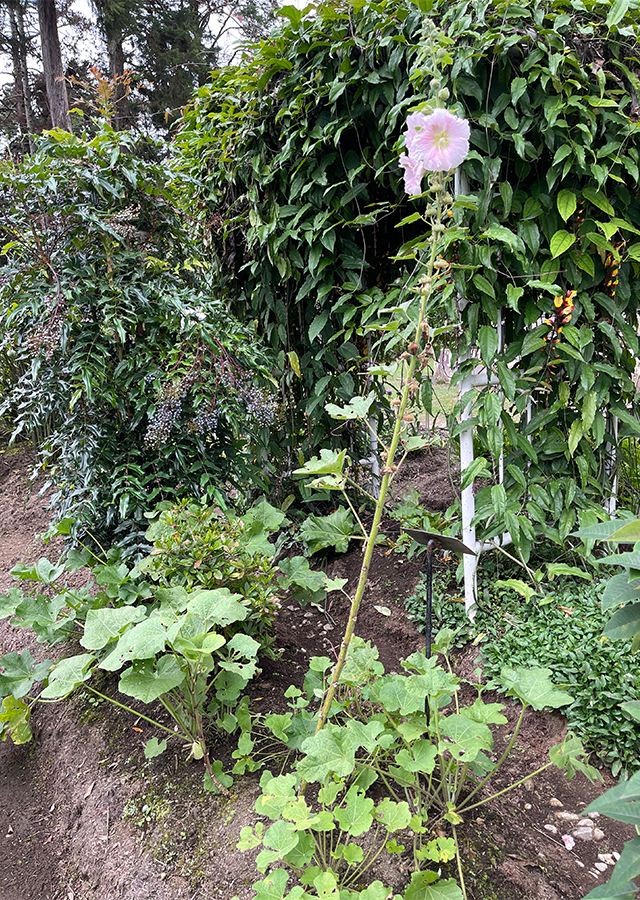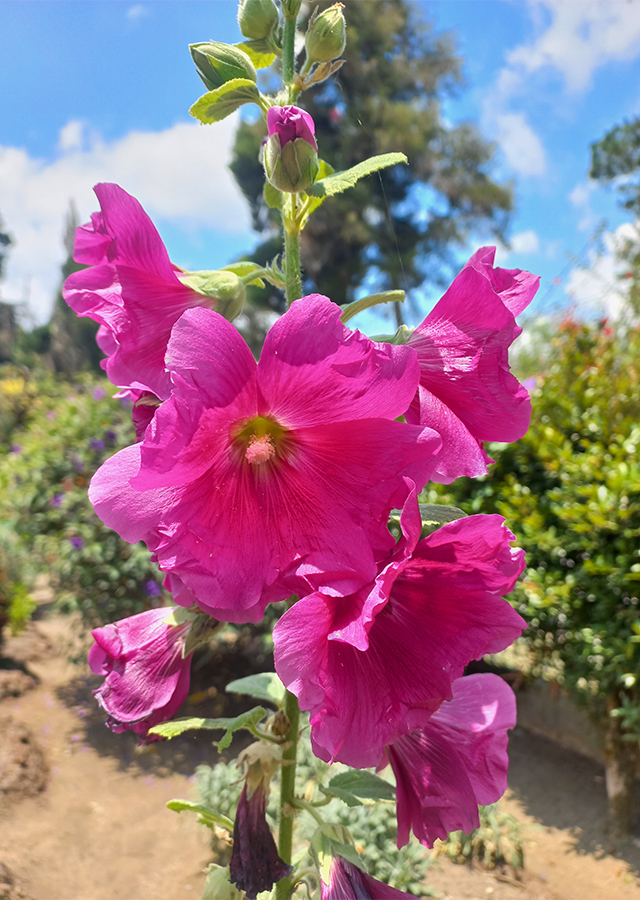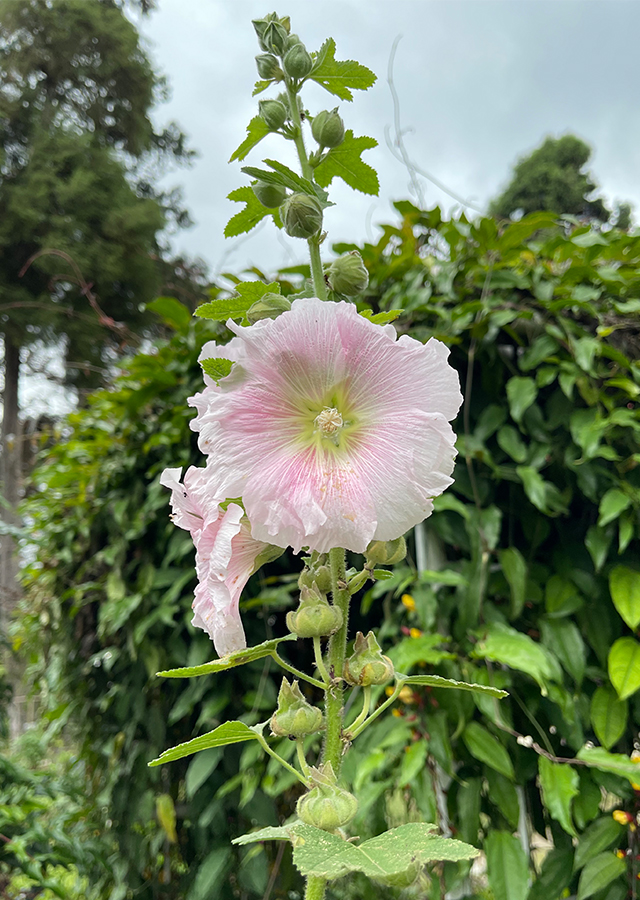Hollyhock
Alcea rosea L.
Malvaceae
Location in our garden
Principal



Synonym
Althaea rosea (L.) Cav.
Malva rosea (L.) E.H.L.Krause
Habitus
Herbaceous. A biennial or short-lived perennial herbaceous that grows 3-4 m tall.
Part Used
Leaves
Seeds
Bark
Flowers
Roots
Growing Requirements
Full Sunshine
Need Shade
Habitat
Coastal
Mountains
Terrestrial
Overview
Alcea rosea is native to China and was introduced to Europe in the 15th century. It is a very ornamental plant and the flowers come in a number of various colours, from lavender to red to yellow, As well as a pretty addition to a flowerbed, hollyhock is widely recognized for its medicinal value, and it is often used as a natural dye in food, cosmetics, and textiles. The stem fibers are used in paper manufacture. The leaves and flowers are edible, and they can be added to all kinds of food without altering the predominant flavors of any recipe. They are often eaten raw as part of a salad, but they can also be added to soups and stews for cooking. Tea made from the leaves and flowers can be a convenient way to consume the herb.
Vernacular Names
Malva Real (Spanish), Passerose (French), Bauernrose (German), Malvarosa (Italian).
Agroecology
Can be found in anthropogenic (man-made or disturbed habitats), meadows and fields. The plant prefers full to partial sun, a heavy, rich, organic soil and seeds, sown in late summer or early fall, will flower the following summer. The plant tolerates a wide range of soil conditions and some light shade, but will not tolerate wet winter soils.
Morphology
- Stems - light green, the stout central stem is unbranched or sparingly branched, terete, and more or less hairy.
- Leaves - green, compound (pinnately, bipinnately, palmately), orbicular shaped, alternate, crenate lobed margin, up to 20 cm long and across; they are palmately lobed (with 3-7 blunt lobes each) and crenate along their margins. Each leaf blade is orbicular or oval in outline and indented at the base. The upper surface of each leaf blade is slightly pubescent to hairless, and wrinkled from fine veins; the lower surface is light green and pubescent.
- Flower - raceme inflorescence, funnel shaped, 4-5 petals, 5-12 cm in size. The overlapping petals are usually some shade of white, pink, or purplish red. The sepals are light green, ovate, and much smaller than the petals. The bracts of each flower are located underneath the sepals; they are light green, hairy, ovate, and joined together at the base.
- Fruit - dry but does not split open when ripe, 20–30 mm long, schizocarp. A fruit containing a ring of 15-20 seeds.
- Seeds - oval, flattened, and notched on one side.
Cultivation
Generatively propagated by seeds - should be sown directly into soil, placed around 30 inches (75 cm) apart. They should not be planted too deep, as the seeds need sunlight to germinate.
Chemical Constituents
Phenolic and polyphenolic compounds, flavonoids, dihydroflavonol glycocides [roseaflavanonolosides A (1), B (2), and C (3)].
Traditional Medicinal Uses
Studies have shown antiinflamation, antibacterial and analgesic effects.
The infusion of leaves and flowers (as tea) is used to combat some cold symptoms, such as a sore throat.
Poultice of flowers, leaves, and stem of the plant is applied to irritated skin. It is said to relieve sore patches.
The Chinese used extract of hollyhock in many traditional remedies, including prescriptions for bronchial complaints, and painkilling preparations.
In traditional Uyghur medicine, hollyhock flowers are regarded as bleed stopping, swell reducing, hypoglycemic or hypolipidemic treatment and detoxification.
Part Used
Reference Sources
- Ahmadi, Marzieh, et al. (2012). Alcea rosea root extract as a preventive and curative agent in ethylene glycol-induced urolithiasis in rats. Indian Pharmacol; 44(3): 304–307. doi: 10.4103/0253-7613.96298.2.
- Herbazest. (2023). Hollyhock. https://www.herbazest.com/herbs/hollyhock. 29-02-2024.
- Magic Garden Seeds. (No date). Common-Hollyhock-Assortment-Alcea-rosea-organic. https://www.magicgardenseeds.com/Common-Hollyhock-Assortment-Alcea-rosea-organic. 29-02-2024.
- Native Plant Trust. (2024). Alcea rosea — hollyhock. https://gobotany.nativeplanttrust.org/species/alcea/rosea/. 29-02-2024.
- N.C. Cooperative Extension. (No date). North Carolina Extension Gardener Plant Toolbox: Alcea rosea. https://plants.ces.ncsu.edu/plants/alcea-rosea/. 29-02-2024.
- Royal Botanic Gardens, Kew. (No date). Plants of the World Online: Alcea rosea L. https://powo.science.kew.org/taxon/urn:lsid:ipni.org:names:558713-1. 29-02-2024.
- Zhang, Yi, and Jin, Lijun, et al. (2015). Hypoglycemic activity evaluation and chemical study on hollyhock flowers. Fitoterapia: Vol.102 (pg.7-14).



